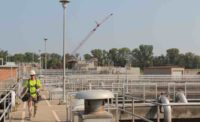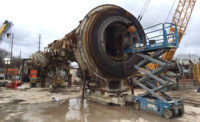Deep Below Indianapolis, Tunnelers Race to Control Waste






Reusing a TBM is cost effective but not always possible due to project parameters, such as the local geology, says Lipofsky, who estimates that a new machine costs about $20 million. (A used machine costs about half that.) "It helps us get work, and it's a cost savings to the owner," Lipofsky says. Because the heavy equipment is specialized and costly, design engineers can help projects find savings by tailoring tunnels to available machines. "When we were sizing the tunnel system, we were looking for the sweet spot in the industry," Morgan adds. "There seemed to be more machines in the 20-ft-dia range."
Another task on S-K's plate was to extend an existing 15,000-ft-long levee by 11,000 ft to wrap around the Southport treatment plant. Designed by Rosemont, Ill.-based Christopher B. Burke Engineering, the new levee, which S-K raised up to 5 ft, aims to protect the plant against a 500-year storm and take it off the flood-insurance map. The tunnel design, prepared by AECOM, was completed under a hectic, 16-month schedule. The owner also hired AECOM, with subcontractor Black & Veatch, for construction inspections.
S-K excavated the 44-ft-dia launch shaft using the slurry-wall method for the first 100 ft—to the top of the bedrock. Blasted out to 39 ft in dia, the rock section then tapers to a concrete-finished tube 35 ft wide. Down at the floor, crews blasted a horseshoe-shaped starter tunnel 478 ft long and 23 ft tall, finished with 4 in. of shotcrete. The main tunnel, drilled out to 20.2 ft and rock-bolted, will have an unreinforced concrete liner with an internal diameter of 18 ft.
The DRTC is part of a landmark settlement between Indianapolis, the state of Indiana, the U.S. Environmental Protection Agency and the Justice Dept. In 2006, federal regulators directed Indianapolis to clean up its act by building 12-ft-dia soft-ground tunnels 60 ft below the surface, upgrading plants and performing other measures. The plan was estimated to cost $1.73 billion, but early work encountered delays and overruns, sending the budget closer to the $2-billion mark.
Mayor Greg Ballard in 2008 brought in industry veteran David Sherman to value-engineer the decree. The city came back with a counterproposal to build wider, deeper rock tunnels, upgrade treatment plants and install green measures that help capture, treat and absorb runoff. Financed through user fees, the revised plan is estimated to save $740 million and treat an additional 3.5 billion gallons a year.
ENR lauded the effort, handing a 2011 Newsmaker Award to Sherman, then director of the city's Dept. of Public Works. Ballard ushered in other reforms that streamlined procurement. At the time the DRTC bid was opened, in August 2011, DPW moved under Citizens as a charitable public trust. "One agency bid the job and a different agency awarded it," notes Morgan.
The new model gives Citizens the flexibility to procure future work privately, and there is a lot more on the way. The upgraded CSO system will include some 40 new drop structures designed with tangential vortices to help channel wastewater into the deep tunnels. The DRTC connects three such structures as well as a 90-mgd pumping station feeding into the Southport plant. The Fall Creek and White River tunnels, now under design by Black & Veatch Corp., are estimated to total 8.6 miles together and cost $389 million. Construction is expected to begin in 2016. Lower Pogue's Run tunnel, designed by Parsons Brinckerhoff and expected to start in 2016, will snake 10,000 ft through downtown Indianapolis and cost about $200 million. The 40,000-ft Pleasant Run tunnel, expected to start in 2020, awaits a designer. All will follow the basic profile of DRTC.
Citizens has tried to anticipate problems through advanced planning and extra soil tests. As lab analysis predicted, the TBM is chewing through ideal rock. "It ranked high on cutter wearability," says Alexander Varas, AECOM vice president. Change orders have amounted to 1.34% of the DRTC project value, mainly due to near-ground structures failing under construction loads. The changes were minimal—the job is months ahead of schedule—but the lesson was learned.
"We did not go out of our way to replace everything prior to having all this heavy equipment on top of piping," Morgan explains. "I'm pushing pretty hard internally for future designs to look at the footprint and replace everything within that. It is just better to replace it while we are there."










